Day #1 - Wednesday, August 30th
Our planned mid-week getaway for 40°F cooler than our triple digits in Phoenix East Valley worked out with lots of super bird sightings.
On our way to Sheep Crossing, a perched hawk caused me to do a quick turn-around for a second look. Yes! — a SWAINSON’S HAWK!
 |
| SWAINSON'S HAWK perched up along entrance road to Sheep Xing (Route 273) |
Reaching Sheep Crossing, I told Hinde Silver, my birding companion, that I frequently found the AMERICAN DIPPER right along the Little Colorado River below the parking area. At one of the openings in the shrubbery across the narrow and full running river, I spotted a bird fly into the bottom of a thick shrub. By the time I told Hinde it might be “our bird”, it promptly flew just a short distance up onto a fallen log aimed toward the river where it began walking back and forth flicking its tail up and down. Not a plain all-gray bird like the Dipper, the one I was looking at had a plain brown back and dark streaking on its white flanks and belly. It showed us its face as it walked toward us and its rear walking away from us. With a long light supercilium above its dark eye and a warbler-like longish bill, I felt confident of calling the bird for the first time ever in Arizona--NORTHERN WATERTHRUSH! Previously, I’ve chased this bird to find it but ended up either missing it entirely or having other birders point out this sought rarity. Too dark for photos in the early morning light and thick shrubs, but we got excellent binocular views before the bird flew off.
Feeling a bit of a rush with these first two sightings - SWAINSON’S HAWK & NORTHERN WATERTHRUSH - I felt a good birding adventure coming on.
That all-gray AMERICAN DIPPER was not at its territory below the parking lot. We walked along the Little Colorado for quite a stretch through wet willow thickets without finding the bird, but continued back up on the trail for a while longer. Each time we came upon openings to the river, we scanned and searched. Found it! - Can you?
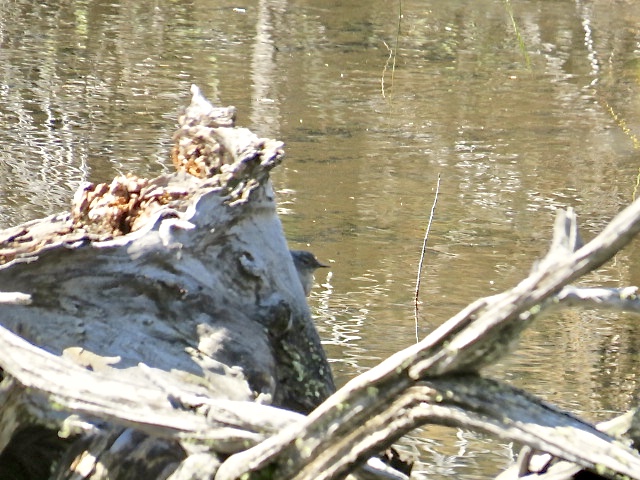 |
| AMERICAN DIPPER |
Staying focused on the bird as it poked around at the edge of this bleached root structure of a fallen tree, we were finally rewarded with its hopping out onto an open limb for a great look. It then dived into the water, swam just a short distance, dipped down once more and came up with a worm to eat...away from our eyes and camera! We also got to see its white eyelid that protects its eye under water...giving us a thorough sighting.
Exploring West Baldy Trail #94 proved interesting, too. We were really searching for the American Three-toed Woodpecker and Williamson’s Sapsucker.
Out of only nine (9) species observed during our 1.2 mile walk, we didn’t feel badly about not seeing those two birds when we got good views of several raptors overhead: very light FERRUGINOUS HAWK, a PRAIRIE FALCON and several RED-TAILED HAWK (already included in our count at Sheep’s Crossing adjacent to this trail).
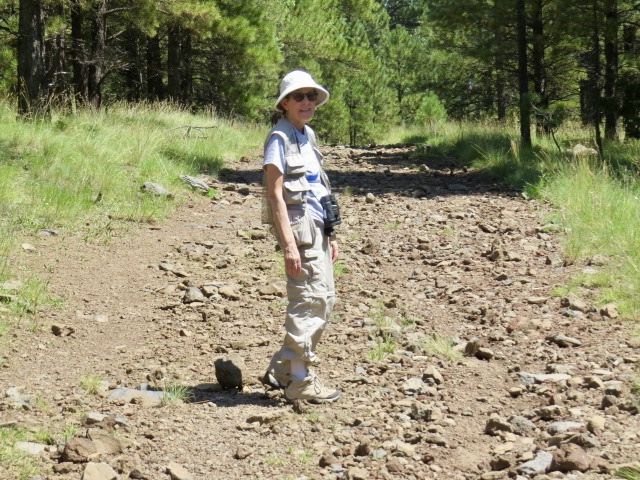 |
| Hinde Silver |
Three GRAY JAYs showed up here, loud and visible, then continued to follow us both up and back on the trail.
 |
| GRAY JAY (above and below) |
Catching a glimpse of one of my favorite birds flying overhead, we both followed it to where it landed and perched on top of a very tall spruce with the morning sun lighting up this mellow-colored gray bird — CLARK’S NUTCRACKER. Its short tail and long bill stood out even in the distance; and when it flew, we were able to see the white undertail as well as the white wing patches on its black wings. In the Jay family, my first acquaintance with this bird was at a parking lot begging for a handout in the Badlands of South Dakota. It is not exactly common here in Arizona but during the summer months is often seen in the area we were visiting.
Next destination: Butler Canyon Nature Trail in Greer.
Hoping to find the two woodpeckers we dipped on along the West Baldy Trail #94, we slowly birded up the trail to its highest point and then followed drumming a bit higher. For over two hours we searched, listened and looked for the Williamson's Sapsucker and American Three-toed Woodpecker. What we found were: DOWNY and HAIRY WOODPECKERs.
This HAIRY WOODPECKER had been drumming for a long time and we finally reached its tree way up on the hillside where the woodpecker was hidden from our view below.
 |
| HAIRY WOODPECKER (above and below) |
 |
| One of many asters growing beside the trail |
 |
| NORTHERN FLICKER (Red-shafted) |
Nuthatches were the most prevalent birds here at mid-day (WHITE-BREASTED and PYGMY) when many birds were resting.
Almost 4 p.m. when we reached Greer Lakes, we birded from the parking areas and didn't search out all the goodies along the three lakes. Even so, we tallied twenty (20) TREE SWALLOWs, an OSPREY, a VESPER SPARROW and a handful of DARK-EYED (RED-BACKED) JUNCOs. What was most striking about the lakes were the blooming wild flowers all around them.
Having never birded "South Fork" so late in the day (4:45 to 5:15 p.m.), we gave it a try, but decided the next morning would prove more interesting. Best bird in our thirty minutes there was a female RUFOUS HUMMINGBIRD.
Day #2 - Thursday, August 31st
A quick visit to Becker Lake had the usual high count of AMERICAN COOT, but also 14 PIED-BILLED GREBEs of various ages (love the striped heads of the young) foraging on the lake. Best find there was the BALD EAGLE perched on a dead snag of a tree across the lake possibly, like us, having already finished breakfast.
Then, it was on to the South Fork of the Little Colorado River to see what might be present around 8 a.m. With a very low species count in our 20-minute timeframe, each one was special:
CALLIOPE HUMMINGBIRD (very very small hummer, short thin bill, metallic green back, light buffy sides);
CALLIOPE HUMMINGBIRD (very very small hummer, short thin bill, metallic green back, light buffy sides);
PINYON JAY - 40 birds (in two successive flocks of 20 each) flew over close enough for us to see their blue under color. Voices gave them away anyway!
MOUNTAIN BLUEBIRD - a male; first and only one of that species seen on the whole trip
GRAY CATBIRD - with shrubs and willow thickets wet with dew beside the river, we opted for a possible "call and response" to locate the bird which is known to reside there this time of year. It was definitely in there and was quick to respond to our playing its call from iBird app.
From there, we continued farther on the road across the South Fork of the river up to the Campground area. One surprise: the dilapidated structures from an old group camp site were missing. No more windowless wooden structures with boards missing; all that remained were the concrete foundations. We didn't enter as it wasn't very birdy on the open side prior to the "old camp site" fenced off area.
Driving farther up to the trailhead, we looked forward to another nice walk in the woods.
MOUNTAIN BLUEBIRD - a male; first and only one of that species seen on the whole trip
GRAY CATBIRD - with shrubs and willow thickets wet with dew beside the river, we opted for a possible "call and response" to locate the bird which is known to reside there this time of year. It was definitely in there and was quick to respond to our playing its call from iBird app.
From there, we continued farther on the road across the South Fork of the river up to the Campground area. One surprise: the dilapidated structures from an old group camp site were missing. No more windowless wooden structures with boards missing; all that remained were the concrete foundations. We didn't enter as it wasn't very birdy on the open side prior to the "old camp site" fenced off area.
Driving farther up to the trailhead, we looked forward to another nice walk in the woods.
When I visited this area about a year ago with other good birding friends (Chris, Gordon and Muriel), it was raining off and on so we didn't walk as far then as we did today. Again wildflowers and tall grasses lined the forest floor.
With the river gurgling and running beside the trail and pooling at the beaver dam, we took time to enjoy our quiet surroundings. All seven NORTHERN FLICKERS were individually foraging at different locations in the deep grasses, not in the trees. A RED-TAILED HAWK circled silently overhead and a high-pitched BROWN CREEPER gave us great views, almost indiscernible on the tree trunk. (It was our second visual of a Brown Creeper on this trip.)
 |
| Can you find the BROWN CREEPER? - low, center of photo against tree bark |
Again, GRAY JAYs showed up to follow along as we bird-walked (not exactly a hiking pace).
STELLER'S JAYs couldn't drown out the voices of the MOUNTAIN CHICKADEEs or GOLDEN-CROWNED and RUBY-CROWNED KINGLETS, both of which were present.
Among the other birds we saw, the five (5) TOWNSEND'S SOLITAIRE proved to be the most of that species I think I've ever seen together. I don't know if it was a family group including young or not, but we observed at least that number and possibly more that flew from that particular area.
As we drove back along toward Greer, it seemed to be time for the cows to cross the road. No other traffic at this time (around noon) so we just stopped until there was a break in their lumbering across the highway. Got too much of the inside of the car in the photo, but this was it:
After eating our packed lunch at the end of the road in Greer, we pointed the car homeward, arriving 40°F hotter than in the 9,000' elevations of some of the White Mountains.
Among the 53 species we saw in 1.5 days, Hinde was able to observe twelve (12) Life Birds and learned that habitat makes a big difference in the birds we see.
* * *
To view our eBird checklists, click on the following links:
View this checklist online at http://ebird.org/ebird/view/checklist/S38928535
View this checklist online at http://ebird.org/ebird/view/checklist/S38928791
View this checklist online at http://ebird.org/ebird/view/checklist/S38929015
View this checklist online at http://ebird.org/ebird/view/checklist/S38929147
View this checklist online at http://ebird.org/ebird/view/checklist/S38929302
View this checklist online at http://ebird.org/ebird/view/checklist/S38929453
View this checklist online at http://ebird.org/ebird/view/checklist/S38929584
View this checklist online at http://ebird.org/ebird/view/checklist/S38929908


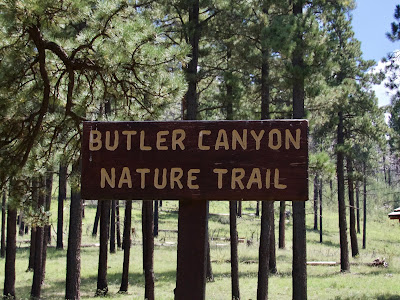





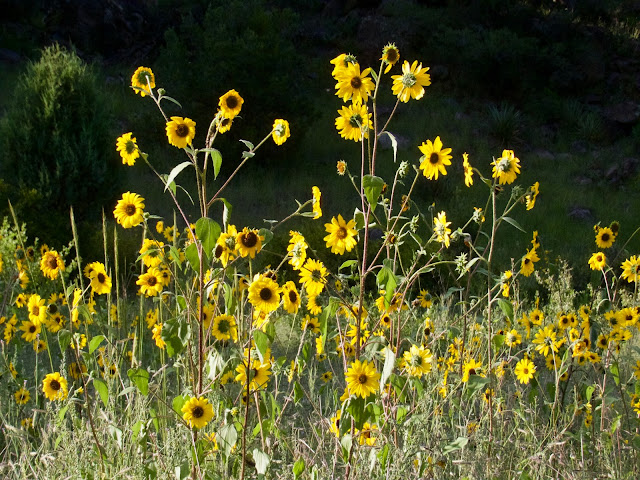

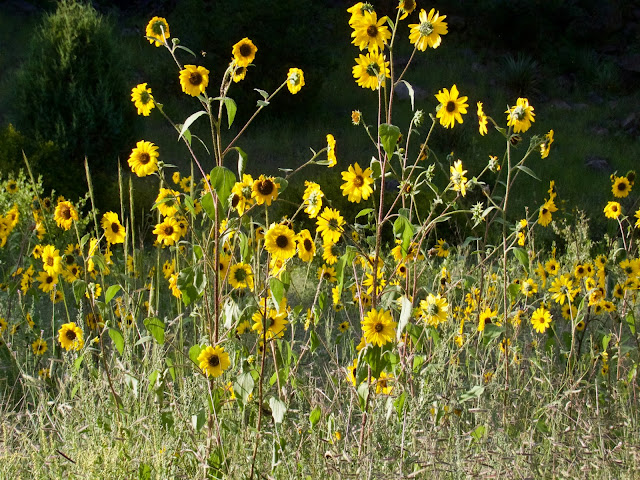

No comments:
Post a Comment